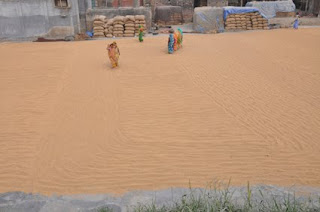After visiting the metal casters I went for a walk around Dhamrai, partly trying to find the school that Shawon had gone to film in and to catch up with him, partly to explore and see what life was like for people living outside of Dhaka. I walked past a rice mill and stopped to spend some time watching and recording the process of drying the rice.
Watch: Drying Rice 06
I had visited and observed a small mill on the 15th whilst visiting the brick fields and had enjoyed the activity and movement of the work.
Watch:Drying Rice 01
Then I had seen just a small part of the process of drying the rice, so this was a chance to see a bit more.
Drying the rice can take up to three days to complete. The men and women were constantly moving, it was like a performance; colaborative working which had a wonderful sound and rhythm to it; a welcome relief from the visual and audible mayhem of Dhaka. During the course of the day the rice is spread out over a large area of smooth concrete, the women regularly walk through the rice kicking it over to encourage the drying process and making wonderful patterns and marks.
It is pulled into small banks, spread out again, walked through, pulled into banks spread out, constantly turning the rice over to allow the rice to dry. The banks make wonderful patterns ridges and troughs like ploughed fields.
At the end of the day the rice is pulled into much larger banks and then covered with cloth to protect it over night.


The circle of red chilies drying in the sun was beautiful against the blue grey of the concrete and the pink/ buff of the rice.
The images and films are from visits to both of the Mills on the 15th and on the 17th.
It is pulled into small banks, spread out again, walked through, pulled into banks spread out, constantly turning the rice over to allow the rice to dry. The banks make wonderful patterns ridges and troughs like ploughed fields.
At the end of the day the rice is pulled into much larger banks and then covered with cloth to protect it over night.
Watch: Drying Rice 04

Watch: Drying Rice 02

Watch: Drying Rice 07
The circle of red chilies drying in the sun was beautiful against the blue grey of the concrete and the pink/ buff of the rice.
Watch: Drying Rice 03
Watch: Drying Rice 08.
After wards we made our way back to Dhaka, saw cow pats drying by the side of the road again making interesting patterns. They are used as fuel to cook with.
In Dhaka we went to meet Shawon Akand and the enthusiastic and committed staff at CRAC; The Centre for Research on Art and Culture.
In Dhaka we went to meet Shawon Akand and the enthusiastic and committed staff at CRAC; The Centre for Research on Art and Culture.

























